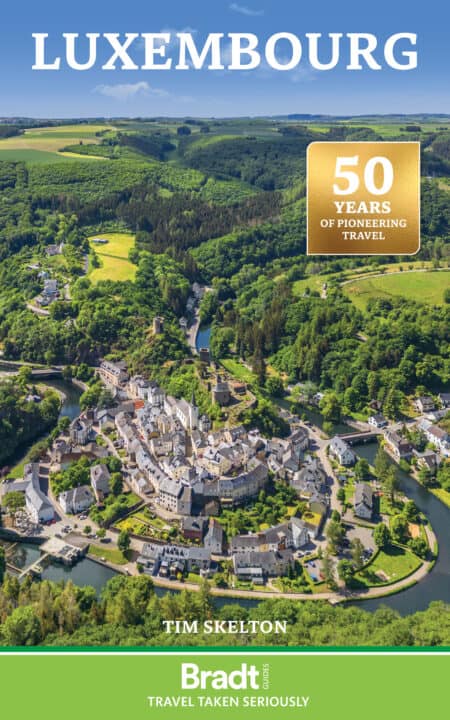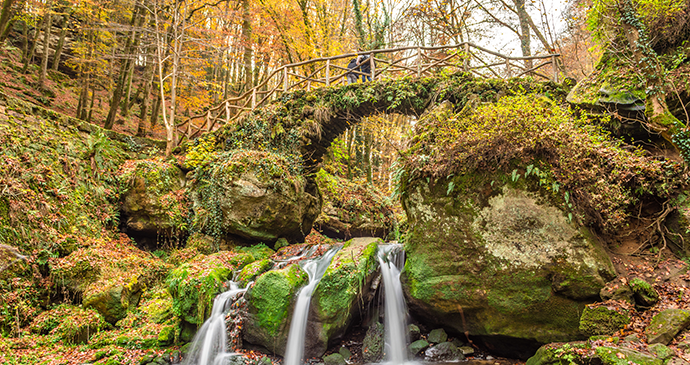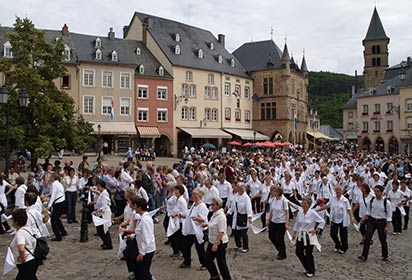You may need to look twice to find it on a map, but Europe’s ‘smallest big country’ shoehorns a lot into an area no bigger than a typical English county.
Tim Skelton, author of Luxembourg: the Bradt Guide
This tiny land’s strategic importance is plain to see. The ruins of dozens of medieval castles, from Bourscheid to Vianden and from Brandenbourg to Beaufort, dot the landscape, bearing witness to the power struggles of would-be conquerors for centuries.
At the centre is the capital, Luxembourg City, straddling two intersecting gorges and guarded by a maze of underground casemates.
Other towns reflect more peaceful times. Echternach’s abbey dates back to the arrival of Christianity in the region, while on the cultural side, two of the world’s best photographic exhibitions have permanent homes in Clervaux and Dudelange respectively.
Those craving the outdoors will love the Ardennes, where the rolling forested countryside is perfect for hiking and mountain biking. The adjoining region of Little Switzerland ups that ante by adding craggy narrow gorges to the mix.
You’re unlikely to go hungry here, as Luxembourgers love their food, combining French finesse and Germanic excess whilst using fresh seasonal ingredients. The result is more Michelin-starred restaurants per capita than any other country. And Luxembourg’s Moselle Valley is one of the wine world’s best-kept secrets.
Best of all, everything is handily packaged into a space so small that even those with limited time can take in a great deal. It’s an ideal European getaway just begging to be discovered.
For more information, check out our guide to Luxembourg
Food and drink in Luxembourg
Food
For those with deep pockets, the good news is that Luxembourg probably has more Michelin-starred restaurants per head (12 in a nation of 600,000) than anywhere else in the world, with truly outstanding cuisine and wine lists to die for. But you don’t need to break the bank in order to eat very well anywhere. Most places, even the top ones, offer a special menu du jour at lunchtime on weekdays, which may include up to three courses sold at a fraction of the à la carte prices.
The biggest influences in Luxembourg restaurant food tend to come from the south, and many dishes are French-inspired. Despite the proximity to Germany you won’t find sausage very often (apart from at festivals), although a central European influence is visible in the regular appearance of veal in tourist areas – particularly in the triumvirate form of veal cordon bleu (stuffed with ham and cheese, and fried in breadcrumbs), veal escalope with cream and mushrooms, and escalope viennoise, also known as wienerschnitzel. These latter dishes pander to tourist rather than local demands, however, so can’t really be classed as ‘typically Luxembourgish’.
The national dish is judd mat gaardebounen (the ‘j’ is pronounced like the ‘s’ in measure): smoked neck of pork, served on a bed of stewed broad beans and accompanied with potatoes sautéed in bacon. It’s hearty, tasty, and the portion sizes oft en verge on the titanic. Another favourite is bouchée à la reine, also called paschtéitchen – chicken and mushrooms in a puff -pastry case. A large vol-au-vent in other words.
Grilled sausages appear on restaurant menus in the form of the slender weinzossis, served with mashed potatoes and a mustard cream sauce – the Luxembourg equivalent of bangers ‘n’ mash. Chunkier mettwurst and grillwurst are sold from outdoor stalls during festivals and other events. You may encounter the latter billed as Luxemburger grillwurst, Lëtzeburger grillwurscht, Luxringer, and other regional alternatives such as Ouringer (in Vianden), but all are essentially the same thing: variations on the classic Germanic bratwurst.
As Luxembourg is landlocked, freshwater fish have had a greater impact on national cuisine than seafood. Trout (truite) is seen everywhere, cooked in a variety of ways, often au Riesling, with a wine/cream sauce. Near the Moselle, two regional specialities to look out for are pike (brochet) in Riesling sauce, and friture de la Moselle: a plate of Moselle river fish of various descriptions and sizes, deep-fried. Eat the latter with your fingers: with larger specimens, chew the flesh off the bone; smaller ones are designed to go down whole in the same way as whitebait.
Drink
Wine
Luxembourg’s home-produced Moselle wines are frequently excellent and several of the larger wineries have caves (literally cellars) that can be visited on a tour for a small fee, usually including a tasting. Almost every café and restaurant stocks at least a small selection alongside its imported (predominantly French) choices. The only exceptions tend to be upmarket Italian restaurants, which may stock only wines from that country.
Local wines sold by the glass in traditional bars and cafés cost €2–4 depending on grape variety (Elbling and Rivaner are cheaper, Riesling more expensive) and location. The vessel in question often used to be the distinctive 20cl engraved bowl with a green stem that’s common in the nearby German Mosel, often one with a small chip out of its base.
Beer
The craft revolution that has shaken up the world brewing industry was slow to reach Luxembourg, but it has now arrived, albeit on a tiny scale. For now, the vast majority of the widely available beers remainlager-style Pilseners created for the mass market and without much attention paid to flavour. If you just ask for a beer in a bar, this is what you’ll end up with – the strength of most offerings hovers in the 5% abv region. Ordering a mini will get you a 25cl glass of draught beer; a humpen is a 33cl glass; and a grande bière 50cl.
Health and safety in Luxembourg
Health
There are no serious health issues to worry about, and no endemic diseases. As in other parts of northern Europe, influenza outbreaks can occur over the winter months. Elderly or vulnerable visitors arriving at this time may therefore wish to consider vaccination before travelling. Insect bites are perhaps the biggest risk in rural areas so it is worth taking an insect repellent. There is also a risk (albeit low) of Lyme disease. It is wise to be up to date with the standard UK vaccinations including diphtheria, tetanus and polio which comes as an all-in-one vaccination (Revaxis), which lasts for ten years.
If you do have an accident or fall ill, the level of healthcare is amongst the best in Europe (and by inference, the world). Residents of EU countries including the UK and Ireland should obtain a European Health Insurance Card (EHIC) before travelling, as this covers the costs of any standard medical treatment you may require. Everyone, including holders of an EHIC, should also take out travel insurance that includes medical costs, as the EHIC doesn’t cover all eventualities, such as repatriation to your home country following an accident.
Travel clinics and health information
A full list of current travel clinic websites worldwide is available on w istm.org. For other journey preparation information, consult travelhealthpro.org.uk (UK) or wwwnc.cdc.gov/travel (US). Information about various medications may be found on netdoctor.co.uk/travel. All advice found online should be used in conjunction with expert advice received prior to or during travel.
Safety
Luxembourg is a very safe place in which to travel. The crime rate is low compared with most places in Europe, and violence a rarity. You can wander round anywhere without fear, although incidents aren’t completely unknown so normal precautions should be taken, particularly late at night. Lone women travellers seldom experience problems, but again the usual common-sense rules apply. Attacks on women do occur, but are rarer than in most western European countries. This is also officially one of the world’s least corrupt lands, so you shouldn’t have to deal with any ‘requests for additional payments’.
Some streets in the immediate vicinity of Luxembourg City’s main railway station – including rue Joseph Junck, directly opposite the entrance – form the red light district and have a local reputation for drug dealing and prostitution. In reality it’s pretty low key compared with larger cities elsewhere, which is just as well because a lot of hotels are located there. Besides having to walk past a few seedy bars, you’re highly unlikely to be disturbed by anything other than loud music, and even here single women are not in any significant danger. There are also a few down-and-outs and winos in the same area, but they’re generally harmless and far fewer in number than you would find in other major capitals.
Of course, nowhere in the world is completely without risk, but a little due care and attention to what’s happening around you should keep you safe. If anything, your biggest annoyance is likely to stem from the drunken behaviour of expat office workers having one too many on their way home on a Friday evening. Antisocial behaviour and assaults (usually alcohol-related) among the nation’s youth are on the rise – or so the national papers will have us believe – but again this is a minor annoyance compared with most countries.
Travellers with a disability
Luxembourg’s efforts to make the country as convenient as possible to people with mobility difficulties are as advanced as anywhere in the world, and disabled visitors should not encounter any unexpected surprises. Most hotels, restaurants and tourist sites are fully accessible to wheelchair users. There may, however, be a few smaller hotels that do not have lifts, and some attractions – not least of all castle ruins on rough ground – may be less easy to visit than others.
For specific queries and the most up-to-date information, contact Info-Handicap, Luxembourg’s national association for the disabled. The multilingual website wheelmap.org has an interactive global map showing accessible and partially accessible properties, including museums, hotels and restaurants. If in doubt, local tourist offices are also usually happy to assist with any special requests from disabled travellers.
LGBTQ+ travellers
Luxembourg’s tolerance of homosexuality is reflected in the fact it has been legal here since 1792. It’s an offence, punishable with a fine or prison sentence, to incite or indulge in acts of hatred, discrimination or violence based on sexual orientation. Gay and lesbian visitors are by and large treated with respect and accorded the same welcome as anyone else. The age of consent for everyone, gay or straight, is 16.
Owing to the country’s low population as a whole, the gay scene is quite limited in scope. The website of the Rosa Lëtzebuerg Gay and Lesbian Association has information about upcoming events in the Grand Duchy, and lists the addresses of gay (and gay-friendly) bars and restaurants.
The election of Xavier Bettel as Luxembourg’s first openly gay prime minister in 2013 has brought further benefits, most notably his pushing of the same-sex marriage bill through parliament in 2014. This bill, which also gives same-sex couples the right to adopt, came into effect on 1 January 2015.
Travel and visas in Luxembourg
Visas
Citizens of EU countries including Ireland can enter Luxembourg for visits of up to 90 days with a valid passport or national identity card. Nationals of 62 non-EU countries, including the United States, Canada, Australia and New Zealand, need only a valid passport to enter for up to 90 days – but passports must also be valid for three months after your intended departure date.
There are plans to introduce a new EU-wide system to keep tabs on visa-free arrivals via the European Travel Information and Authorisation System (ETIAS), a similar arrangement to the US ESTA. Once it is implemented (likely to happen in 2020), citizens of these countries will get charged (possibly €7) for the pleasure of undergoing an online security check. Another post-Brexit bone of contention will be whether UK citizens will be included in or can gain exemption from this charge.
Citizens of most African states, including South Africa, and some Asian nations (but not Hong Kong, Japan, Malaysia, Singapore or South Korea, whose citizens require only a valid passport), need to obtain a Schengen visa before travelling. These entitle holders to enter one country and travel freely throughout the 26 countries of the Schengen zone, which includes Luxembourg, for stays of up to 90 days within a six-month period.
If you intend only to visit Luxembourg, or Luxembourg is your main destination, you must apply for the visa at a Luxembourg embassy. Applicants living in countries where Luxembourg has no consular representation should apply at the Belgian embassy or consulate. Otherwise you must apply to the embassy of the country that is your main destination. If you intend to visit several countries, but don’t have a main destination, apply at the embassy or consulate of the country that is your first point of entry.
Getting there and away
With its handy location at the heart of the continent, reaching Luxembourg from the UK and other points in Europe is a straightforward matter. There is a wide range of transport options available that will get you to the Grand Duchy by plane, train or automobile in a matter of a few hours. From further afield, the lack of direct inter-continental air routes makes life slightly more complicated. Nevertheless, several European hub airports offer easy onward connections for far-flung arrivees.
By air
Luxembourg’s Findel Airport has all the usual facilities, including a newsagent, bank, café/restaurant, and information desk. Arrivals are on level –1; check-in, departures and shops on level 0. Level 1 landside has a self-service restaurant with panoramic windows, and a more upmarket brasserie (open: 11.30–14.30 Mon–Fri) that will refund two hours of parking. There are more bars and restaurants airside. The taxi rank is on the right as you exit; the bus stop (9 or 16 for downtown) to the left. The major car-rental firms have offices on level –1, on the left as you emerge through arrivals.
By car
I’d love to be able to tell you to leave your car behind, but for now the most popular and practical way to reach Luxembourg as an independent traveller remains the car. Once you arrive it has the advantage of liberating you from sometimes-limited public transport connections, and fuel prices are relatively low (by northern European standards). On the downside, having your own vehicle may become a burden in Luxembourg City where parking is expensive. Driving times from the Channel ports should be around 3½ to 4 hours.
By train
To reach Luxembourg from the UK by rail you have two choices: one is to take the Eurostar from London to Brussels-Midi and change to an intercity; the other is to ride the Eurostar to Paris Nord, then take a TGV from Gare de l’Est. Both routes take the same time: 5½–6 hours depending on connections. One slight disadvantage of travelling via Paris is that you need to transfer between main line stations to continue (an easy 500m walk, or 5minutes by metro), whereas the transfer in Brussels is within the same building. Another point in favour of Brussels is that you don’t have to reserve on a specific onward train, whereas you do for the Paris TGV: if you miss your connection due to a delay you have to re-book.
Getting around
By bike
Cycling has historically been the one sport at which Luxembourg competes on equal terms with the world’s best. François Faber (in 1909) was the first non-Frenchman to win the Tour de France, and Nicolas Frantz (1927 and 1928) and Charly Gaul (1958) have also won the coveted race. Half a century later, the country’s two more recent heroes, brothers Fränk and Andy Schleck, began emulating these past legends, and their exploits have sparked a new wave of interest in cycling across the country.
It isn’t surprising then that there’s an extensive network of cycling and mountain-biking routes short and long for you to choose from if you want to get around under pedal power. Be warned, however, that if you get tired you aren’t allowed to take your bike on the bus. Bookshops and some tourist offices sell a map (Luxembourg by Cycle, €5) showing every dedicated cycle path in the country.
By bus and train
Getting around by public transport is very cheap, and simple in all but the remotest areas. On quieter routes the regularity of service tails off dramatically on Sundays – bear this in mind if you need to do much travelling then.
For short journeys buy a ‘short duration’ ticket (billet ‘courte durée’), valid for two hours. These can be bought for €2 each, or in packs of ten (carnets à dix billets) for €16. If you travel a lot, go for the ‘long duration’ ticket (billet ‘longue durée’) for €4 (€16 for five), valid all day and until 04.00 the following morning. All tickets can be used on any bus or train (second class), including transfers. Travel on all buses and trains (second class) is free with a Luxembourg Card.
By car
Driving distances are never that great in Luxembourg, the roads are in excellent condition, and with your own vehicle you can see a lot in a little time. The winding roads and sparse traffic in the north are also particularly popular among motorcycling enthusiasts. All major car-rental companies have offices in Luxembourg City and at Findel Airport. Some are also represented in Esch-sur-Alzette, but are a rare find elsewhere. Expect to pay €40 per day and up, depending on size of car and length of hire.
On foot
A great way to get a feel for the countryside is to walk through it. There are hundreds of hiking routes available, ranging from a couple of kilometres to several hundred. If you hit the trails during the week, then even in summer you may find yourself alone with the skylarks. In all regions, short walks are waymarked with letters; medium-length routes with numbers; and long national paths with symbols. Tourist offices throughout the country carry walking maps for their region.
When to visit Luxembourg
You can visit Luxembourg at any time, but bear in mind that the availability of services in some regions varies with the seasons. May, June and September are usually very pleasant months, as the weather is often at its most benign during late spring and late summer. July and August are also recommended, as they tend to be slightly warmer, if marginally wetter and busier.
In much of the Ardennes, mid-July to the end of August is considered ‘high season’, and it’s only at this time of year that everything is fully open. Outside this period some attractions may be closed or have limited opening hours. Many smaller hotels and restaurants shut during the winter months, limiting your eating and sleeping choices. Autumn, however, can be lovely in the north as the weather is not too bad, and the annual turning of the leaves provides a wonderful and free spectacle. Moreover, many country hotels have open fireplaces for warming your feet during colder evenings.
In Luxembourg City, restaurants, hotels and most attractions remain open all year. There’s no specific high or low season for tourism, but one big advantage of arriving in July or August is that room rates, especially in top hotels, can drop dramatically as the business trade temporarily evaporates. Hotels tend to fill up around the National Day celebrations (22–23 June), so book ahead if you plan to be in town then. Winters are rarely severe, and indeed December can be a great time to visit the city as it allows you to check out the Christmas Market on the place d’Armes.
Climate
Like much of northwest Europe, Luxembourg enjoys a temperate climate without extremes, not dissimilar to the UK. The sea is some 300km away, so its moderating influence is less than in Britain, and the ‘continental effect’ has marginally more impact. This makes winters slightly cooler and summers a bit warmer. January maximum temperatures in Luxembourg City average 5°C, while July maximums average 23°C. May and June are often the driest, sunniest months, while July and August are the hottest. It can rain at any time however, so come prepared – as with Britain, luck plays a major role in whether you stay dry, no matter what the season.
The Ardennes, being higher, is cooler than the south throughout the year. Winter often brings snow, although with less reliability than in past years. The north is also notably wetter.
Having said that, anyone who’s experienced the vagaries of British weather in recent times knows weather trends are no longer as predictable as they once were. Summers may be scorching one year, miserable the next. One winter it might snow heavily and often, the next not at all – the once-thriving cross-country skiing industry (Langlaufen) in the Ardennes has all but vanished now conditions have become so unreliable.
Whatever else: expect the unexpected.
What to see and do in Luxembourg
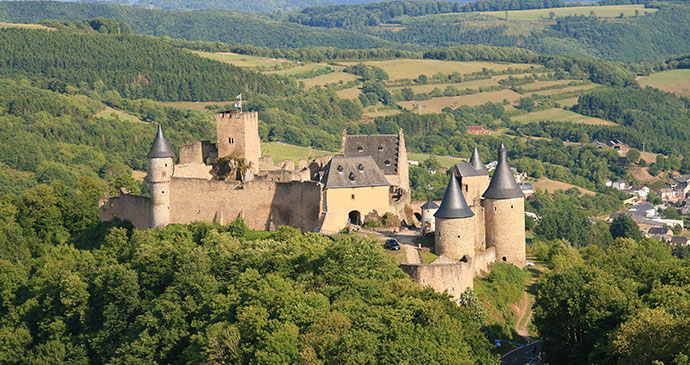
Bourscheid Castle
This grand old castle’s commanding position on a rocky spur completely dominates the Sûre Valley in every direction. One look at its strategic location leaves one in no doubt as to why the local lord chose to build his defensive stronghold here. You’d have to be a fool, or have wings, to attack it.
The first stone keep appeared around AD1000, replacing an older wooden construction, and archaeological digs have uncovered evidence that the Romans – no slouches in military terms – were here too. The major fortifications were built in the 14th century, but the glory days didn’t last long. By1512, the ruling Bourscheid dynasty had died out, leaving the castle divided into two. One half was never occupied; the other was abandoned in 1626. Despite centuries of neglect, the setting and sheer scale make this an exhilarating place to visit, arguably number two (after Vianden) in the unofficial national castle league. Ringed by a great stone wall with 11 watchtowers, the site covers an area of 150m by 50m. Clamber over the ruins and explore at your leisure, but don’t miss the quite wonderful views from the top of the tallest tower (No 14 on the plan you’ll be given with your entry ticket). The restored ‘Stolzembourg’ house is a multi-level mansion that hosts exhibitions, as well as models of the castle as it would have looked through the ages. For more detail than you could ever absorb, take the informative audio guide tour (included in the ticket price). One day each July (usually the second Sunday) the castle hosts its own medieval festival, on a similar theme, but smaller in scale to the one in Vianden.
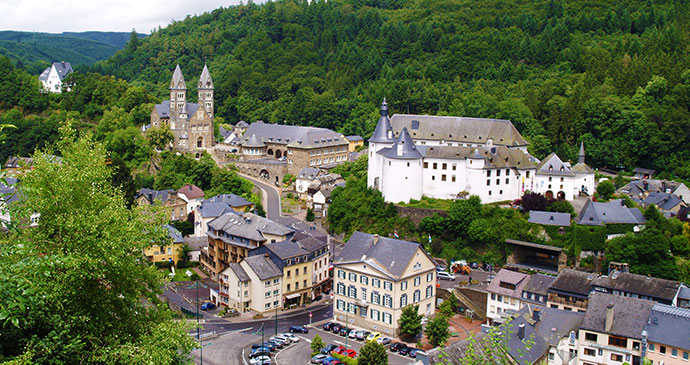
Clervaux
Approaching Clervaux by road, you may have little idea it’s there at all until you stumble upon it. Hidden in a valley and surrounded by plateaux, the only clue indicating human habitation is the tower of Clervaux Abbey peeking above the horizon. The main approach road from the east drops dramatically off a ridge via a series of hairpins, offering great views of the charming little town with its pretty church, and the strikingly white castle at its centre – the whole area feels hemmed in by the sheer wooded slopes all around. The castle is home to ‘The Family of Man’: the world’s greatest photographic exhibition, recognised by UNESCO for its cultural importance.
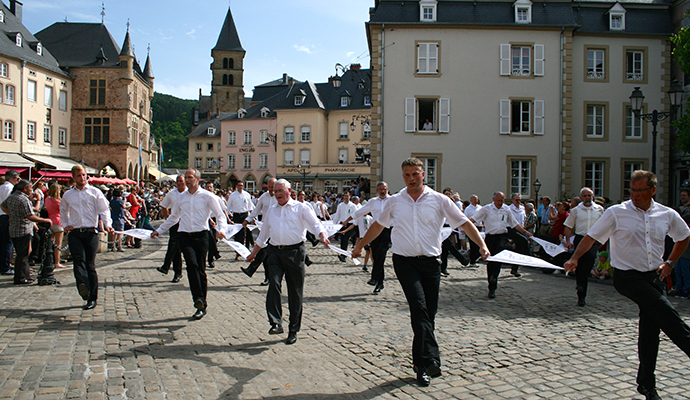
Echternach
When I first saw Echternach I was immediately smitten. On the German border, by the banks of the River Sûre, it’s a simply lovely place, which anyone with a soft spot for old European architecture will enjoy. With its arched shop frontages and wrought-iron shop signs, from some angles and with a favourable wind you may blink and think you’ve been transported to Salzburg, but in miniature. Yet even with a population of almost 5,000, Echternach still evokes a cosmopolitan city feel that belies its stature. And with a great choice of hotels, restaurants and bars it also makes an ideal base for a day or three while exploring.
The town is dominated by its medieval abbey, founded in AD698 by St Willibrord – a Northumbrian monk – whose body lies in the crypt of the basilica. Around that, some of the old city walls remain intact, and several of its original watchtowers have been restored, fitted with all mod cons, and made available as holiday apartments. In May and June, music fills the air as the Echternach International Music Festival comes to town. And on Whit Tuesday, thousands participate in the annual Dancing Procession.
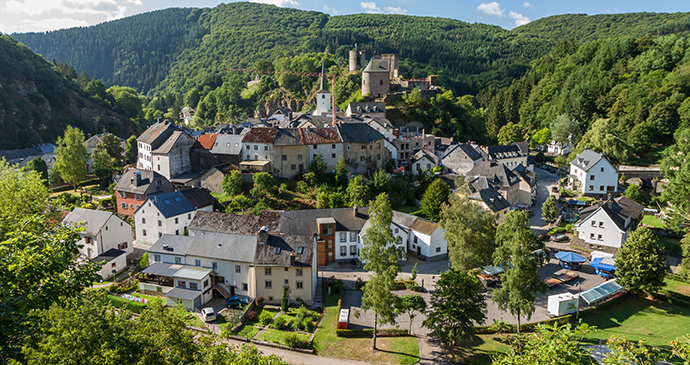
Esch-sur-Sûre
Before you even reach Esch you know something special is happening. Turning off the main road between Bastogne and Ettelbruck, the first thing you do is pass through a rock tunnel. It already feels like entering a secret world. And then you round the last bend and see the village proper, and it just gets better. Make no mistake: Esch is gorgeous, displaying a near-fairytale quality. It clings to the sides of a giant rock that’s been marooned by a sharp meander in the Sûre River. Looking down from above are romantically crumbling castle ruins. At the southern end of town is a second tunnel (rather prosaically, both were actually bored in the 1950s to allow construction traffic to access the Upper Sûre barrage). The river bends so severely it turns the land into a virtual island, connected to the ‘mainland’ only by a narrow isthmus. If you were so inclined you could use the 80m tunnel to bypass the entire place in under five seconds – but why would you want to do that?
Esch has few actual distractions to keep you entertained, but the big draw is the village itself. It’s just a fine place to be. Go walking in the surrounding region by day, and enjoy hanging out in Esch by night. Or just sit and enjoy the view. You won’t be alone though: while the official population is little more than 300, the numbers swell many-fold on sunny weekends.
Craggy outcrops, deep gorges and winding pathways abound in Luxembourg’s very own ‘Little Switzerland’ © Abhinav Malasi, Dreamstime
Little Switzerland
When Dutch tourists first arrived in this area a century ago, they took one look at the rugged rocky landscape and immediately dubbed it ‘Klein Zwitserland’ (‘Little Switzerland’). Compared with the flat farmlands of the Netherlands it may indeed seem like the Alps, but we should put things in a little perspective. Don’t be fooled into expecting extensive snow-capped vistas because you’ll leave disappointed – the highest point is, after all, only 414m above sea level.
What you will find is a maze of spectacular craggy outcrops, pathways, gorges and valleys. Situated between Beaufort and Echternach, and completely encompassing Berdorf, it has some of the best walking routes and the most sublimely beautiful scenery in the country.
Like many of nature’s greatest creations, Little Switzerland owes its existence to water. It formed over a million-year period as the Ernz Noire and Hallerbach rivers gouged away at the sandstone plateau, a former seabed that had covered the area for 20 million years. When the sea receded, time and weathering, particularly of limestone deposits accumulated in cracks in the sandstone, eventually carved the exposed rock into gnarled and twisted formations.
This isn’t just a land of breathtaking beauty; it’s also tranquil and very peaceful. Beyond the clomping footsteps of fellow hikers the air is filled with birdsong and gently trickling water. Best of all, it’s easily accessible for hikes of almost any length, with well-maintained trails and clear signposting. Many of the best start and finish right by the bus station in Echternach. Visit the information offices in Echternach, Beaufort or Berdorf to pick up maps.
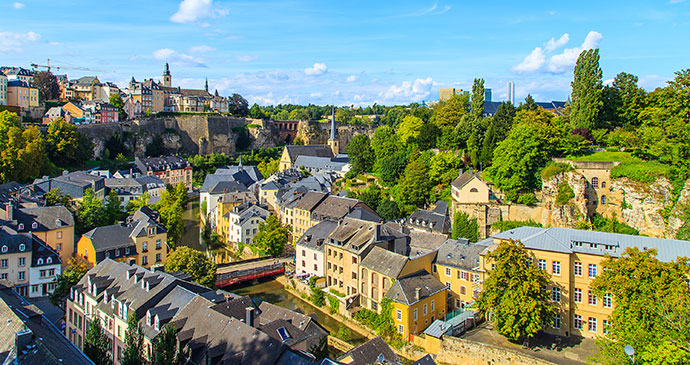
Luxembourg City
‘Gibraltar of the North’, one of Europe’s smallest capitals, or Eurocrat heaven. Think of it how you will, Luxembourg City is many things to many people. But put it all together and what you find is a place of manageable scale, with abundant charm and one of the most stunning settings of any urban area in Europe. At the confluence of the Alzette and Pétrusse rivers, both of which have cut deep gouges into the sandstone plateau, it’s the old town’s spectacular location, perched on a cliff edge, which grabs your attention right away. Its ‘Gibraltar of the North’ tagline actually refers to the fortifications dug into the rock – in appearance I think ‘Edinburgh of the Continent’ is more apt (although I concede it doesn’t scan as well). Lacking the overwhelming scale of London or Berlin, this is a city you can navigate on foot, with plenty of pleasant squares, surprising amounts of green, great museums and intact centuries-old architecture. In short, it’s a delightful place, and UNESCO clearly agrees: it awarded the old town World Heritage status in 1994.
Quaint and appealing as it is, the city also has a hard-working business and administrative side, which has made it wealthy. It’s a major centre of international banking, the seat of several significant European institutions, and (along with Strasbourg and Brussels) one of three capitals of the EU. Despite its permanent metropolitan population being just 114,000, these roles have turned it into the most multi-cultural of cities – around 60% of the residents are of foreign origin. The population also more than doubles every working day, when 120,000 migrant workers flood in from Belgium, France and Germany. When everyone goes home in the evening it can feel strangely empty in the centre, with only tourists and the remaining locals left to frequent the bars and cafés.
This is the only place to have become European Capital of Culture twice, having held the honour in both 1995 and 2007. The title may have since passed on, but its legacy is in plain view, as large sums of public money were poured into creating prestige sites such as the MUDAM Museum of Modern Art and the neighbouring Philharmonie Concert Hall, both gems of modern architecture. New and old, there’s more than enough here to keep you occupied for days.
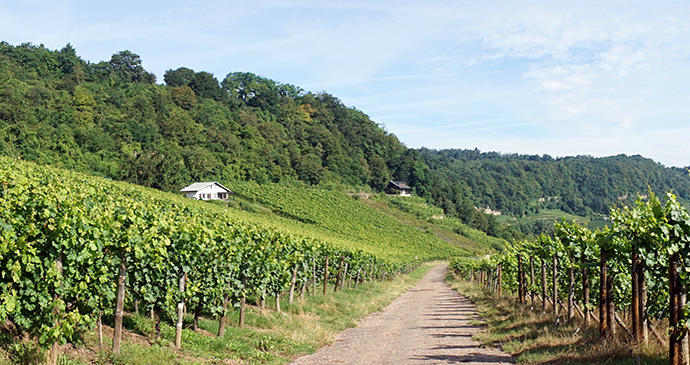
The Moselle Valley
The wines of Luxembourg are an undiscovered secret, itching to take the world by storm. Few people outside the country are even aware they exist. And still fewer have noticed how good they are. Until now …
Oft-overlooked by the wider world, one of Europe’s smallest wine-growing regions stretches a mere 42km along the west bank of the Moselle River, which briefly grazes the Grand Duchy en route between France and Germany. The country as a whole has around 1,350ha of vines, but the overwhelming majority are here – besides its fertile soil, the location enjoys a microclimate particularly suited to winemaking.
A visit to this region is a must for wine enthusiasts. Not only will you be impressed by the quality, the prices may also come as a pleasant surprise, both in the shops and in bars and restaurants. Some wineries are happy for visitors just to turn up at the front door, and you may get a free tour and tasting (larger places tend to charge for these privileges). You’re generally discouraged from appearing at smaller premises at harvest time, simply because the overworked staff are too busy. Besides buying wine, there are several wine museums here, and practically every village holds its own festival, with attendant tasting opportunities, naturally. The two biggest events are the Grevenmacher wine festival and the Riesling Open.
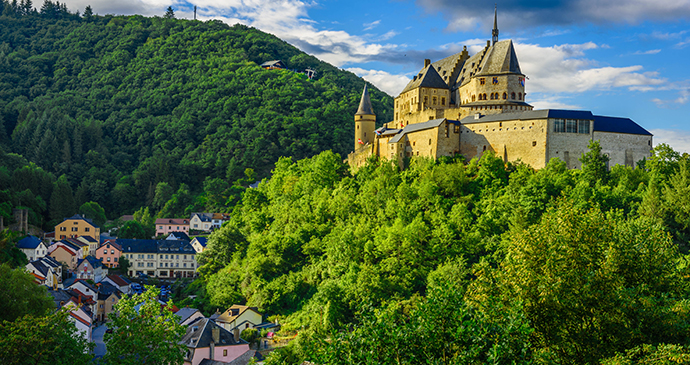
Vianden
Nestled in a steep valley on the banks of the Our River, Vianden’s setting alone would make it worth visiting. But the addition of one of Europe’s most impressive medieval castles, perched on a rock gazing imperiously down over the small town, sends its tourism credentials rocketing skyward. When you add the museums, churches, views, and an adventure rope garden for the restless, it becomes somewhere no-one should miss. It may not cover a huge area, but it packs an awful lot into a tiny space, and in-between are at least a dozen hotels and an even greater choice of eateries.
One thing you may notice is that the vast majority of your fellow visitors are Dutch. They clearly know what the rest of the world is just waking up to. Many signs and menus are designed in response to this, and aimed to appeal to Dutch tastes. You’re as likely to be greeted with a ‘goedemiddag’ as you enter a restaurant here as you are a ‘Bonjour’ or ‘Moiën’.
The local population certainly enjoy throwing a party and dressing up. All manner of special rituals, festivals and markets are held throughout the year, and if your arrival coincides with one of these it’ll add an extra dimension to your visit.
Walking around Vianden presents the visitor with something of an enigma. It’s one of Luxembourg’s most-visited spots, and deservedly so. The main streets in the centre are lined with bars, hotels, cafés and restaurants. There are places modelled on Swiss chalets, with eateries serving cheese fondue to perpetuate the illusion, and a chairlift to carry you up to a lofty viewpoint. This is full-on Touristville. Yet take two steps down practically any side street and it’s as if you’ve been transported to another world: into a quiet rural village with cobbled streets, where the smell of wood smoke lingers in the air even in summer, and where you feel that to breathe too heavily would disturb the sleeping dogs. The two conflicting halves together are what make Vianden such a vital and enjoyable place to be.
Related books
For more information, see our guide to Luxemebourg:
Related articles
You take a step to the left… and then a step to the riight.
